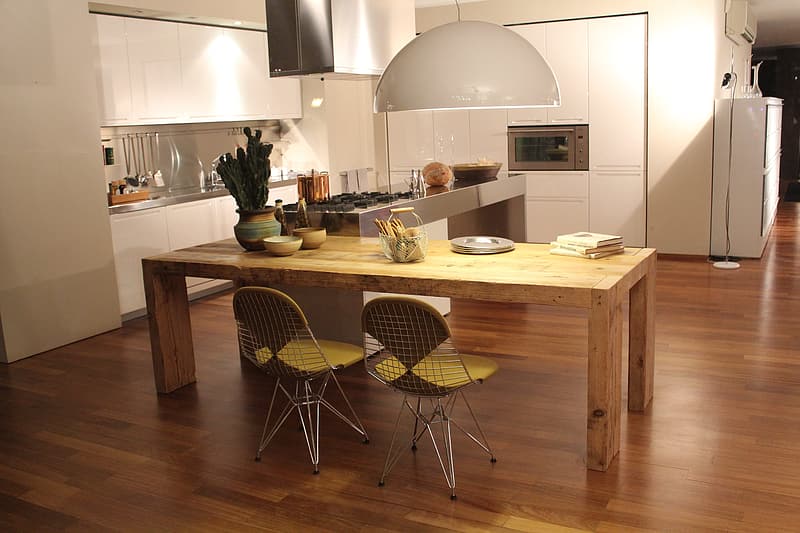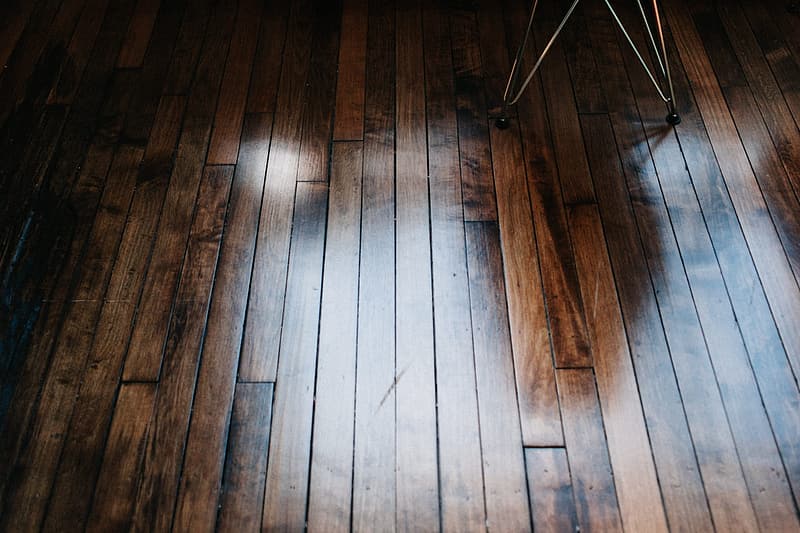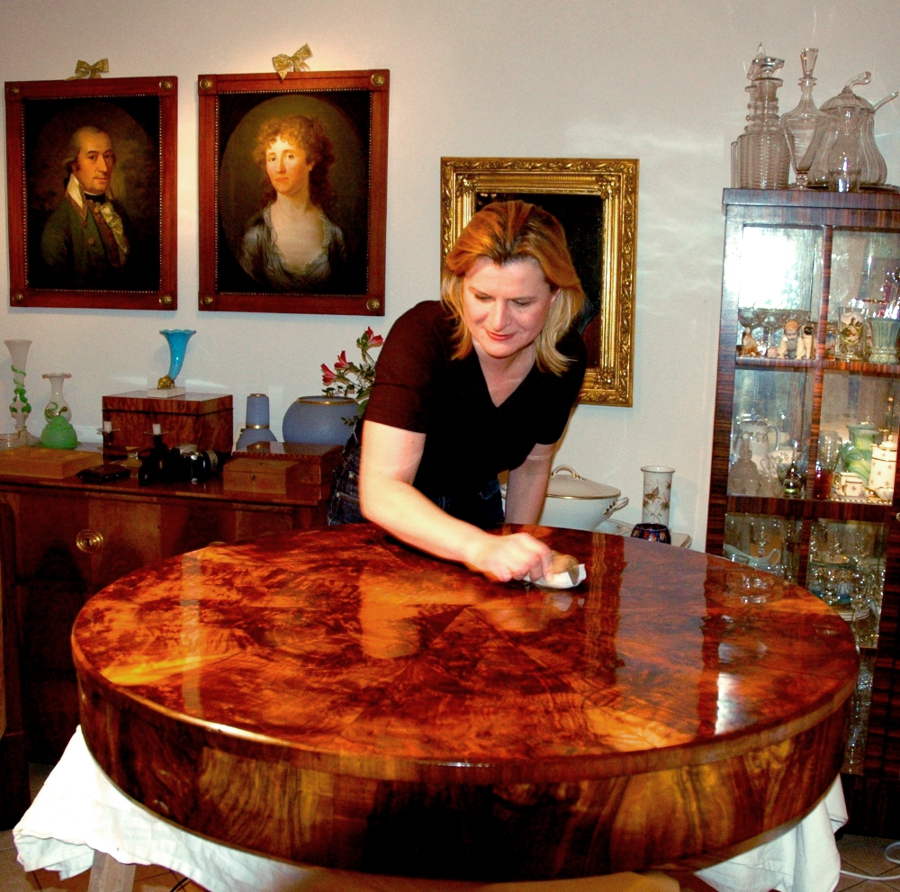The Best Ways to Clean and Protect a Wooden Table
Do you own a wooden kitchen or dining table? Most of us would answer that question with a yes! Most of us have them, yet plenty of us find ourselves with water rings, scratches, and think there is not much else to be done. Here are some really great tips on how to take care of your wooden table and clean and protect it properly. You can finally say goodbye to those dang water rings! Yay!!
I figure right now with us all being home so much, we might as well spiff up those old tables and get them to really shine!

HOW TO CLEAN AND BEST PROTECT A WOOD TABLE
1. Dust your wood table often.
You might not think that a layer of dust is doing too much harm to your wood table, but enough buildup can scratch the wood’s finish. Dust at least weekly with a soft, lint-free cloth. Stay away from the typical specialized dust polishes, since they contain silicones that can soak into the grain of the wood and damage it for good. Instead, lightly dampen a cloth with water or use a microfiber cloth that will cling to dust particles on its own.
2. Use vinegar and oil to get water rings out of your wooden table.
If, unfortunately, you have water rings on your table from wet glasses, mix up equal parts vinegar and olive oil and use a soft cloth to apply it to the ring, moving with the wood grain. Follow that up with another clean, soft cloth. Rubbing mayonaise in this way is another very popular way to solve this problem. These are both highly recommended tips, but all wood and finishes are different from each other and some methods might not work as well as others. Make sure to try and test this on an inconspicuous area first.
3. Keep it away from the radiator.
If you happen to live in a home with a radiator or other heat source, like a fireplace that you use often, just remember that the temperature swings can damage the wood with warping or splitting. Also, try and make sure to store any extra leaves near the table itself. This ensures the leaf will not warp or swell/contract differently from the table. If the leaf is stored in the basement or attic, the moisture and temperature differences could take its toll.
4. Watch humidity levels.

Most every home has plenty of real wood in it, whether that is hard wood floors, trim, wood furniture etc. Did you know that it is best for these wooden pieces to be in a home that has humidity levels between 40 and 45%? Any lower could crack the wood and any higher could cause swelling. Try your best to do this , so typically this means running a humidifier in the winter and a dehumidifier in the summer.
5. Make your Wood table shine with the right product.

Remember to skip using the traditional dusting sprays which contain silicone. Instead, polish the wood with a hard, carnuba wax. Use to lint-free cloths again: one to apply the wax and another to polish. It will take plenty of good old fashioned elbow grease, but the good news is that you will only have to do it about twice a year.
I figure right now with us all being home so much, we might as well spiff up those old tables and get them to really shine!

HOW TO CLEAN AND BEST PROTECT A WOOD TABLE
1. Dust your wood table often.
You might not think that a layer of dust is doing too much harm to your wood table, but enough buildup can scratch the wood’s finish. Dust at least weekly with a soft, lint-free cloth. Stay away from the typical specialized dust polishes, since they contain silicones that can soak into the grain of the wood and damage it for good. Instead, lightly dampen a cloth with water or use a microfiber cloth that will cling to dust particles on its own.
2. Use vinegar and oil to get water rings out of your wooden table.
If, unfortunately, you have water rings on your table from wet glasses, mix up equal parts vinegar and olive oil and use a soft cloth to apply it to the ring, moving with the wood grain. Follow that up with another clean, soft cloth. Rubbing mayonaise in this way is another very popular way to solve this problem. These are both highly recommended tips, but all wood and finishes are different from each other and some methods might not work as well as others. Make sure to try and test this on an inconspicuous area first.
3. Keep it away from the radiator.
If you happen to live in a home with a radiator or other heat source, like a fireplace that you use often, just remember that the temperature swings can damage the wood with warping or splitting. Also, try and make sure to store any extra leaves near the table itself. This ensures the leaf will not warp or swell/contract differently from the table. If the leaf is stored in the basement or attic, the moisture and temperature differences could take its toll.
4. Watch humidity levels.

Most every home has plenty of real wood in it, whether that is hard wood floors, trim, wood furniture etc. Did you know that it is best for these wooden pieces to be in a home that has humidity levels between 40 and 45%? Any lower could crack the wood and any higher could cause swelling. Try your best to do this , so typically this means running a humidifier in the winter and a dehumidifier in the summer.
5. Make your Wood table shine with the right product.

Remember to skip using the traditional dusting sprays which contain silicone. Instead, polish the wood with a hard, carnuba wax. Use to lint-free cloths again: one to apply the wax and another to polish. It will take plenty of good old fashioned elbow grease, but the good news is that you will only have to do it about twice a year.
Sources:
blog comments powered by Disqus
- www.pikrepo.com
- www.thekitchn.com
 Mary Richardson
Mary Richardson
Weekly Newsletter Contributor since 2014
Email the author! mary@dvo.com
